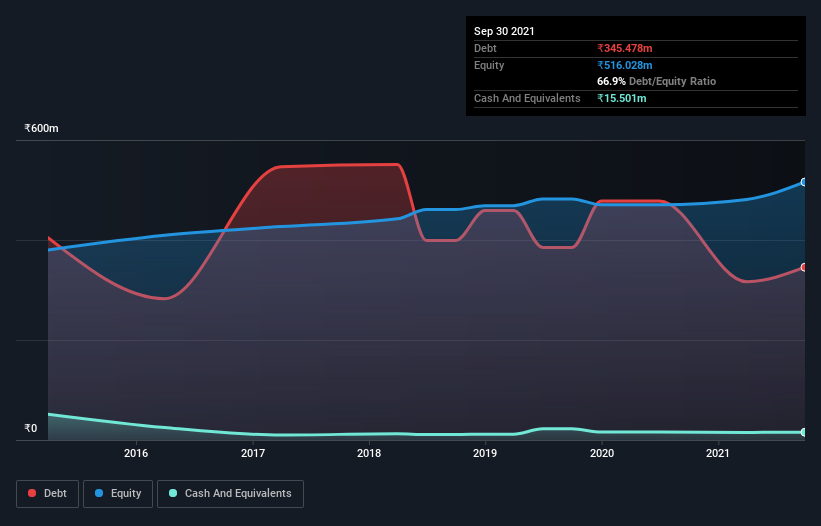We Think Laxmi Cotspin (NSE:LAXMICOT) Can Stay On Top Of Its Debt
David Iben put it well when he said, 'Volatility is not a risk we care about. What we care about is avoiding the permanent loss of capital.' So it seems the smart money knows that debt - which is usually involved in bankruptcies - is a very important factor, when you assess how risky a company is. We note that Laxmi Cotspin Limited (NSE:LAXMICOT) does have debt on its balance sheet. But the real question is whether this debt is making the company risky.
What Risk Does Debt Bring?
Debt assists a business until the business has trouble paying it off, either with new capital or with free cash flow. Ultimately, if the company can't fulfill its legal obligations to repay debt, shareholders could walk away with nothing. However, a more common (but still painful) scenario is that it has to raise new equity capital at a low price, thus permanently diluting shareholders. Of course, the upside of debt is that it often represents cheap capital, especially when it replaces dilution in a company with the ability to reinvest at high rates of return. When we examine debt levels, we first consider both cash and debt levels, together.
See our latest analysis for Laxmi Cotspin
How Much Debt Does Laxmi Cotspin Carry?
As you can see below, Laxmi Cotspin had ₹345.5m of debt at September 2021, down from ₹478.1m a year prior. On the flip side, it has ₹15.5m in cash leading to net debt of about ₹330.0m.

A Look At Laxmi Cotspin's Liabilities
According to the last reported balance sheet, Laxmi Cotspin had liabilities of ₹287.6m due within 12 months, and liabilities of ₹170.9m due beyond 12 months. On the other hand, it had cash of ₹15.5m and ₹387.7m worth of receivables due within a year. So it has liabilities totalling ₹55.3m more than its cash and near-term receivables, combined.
Given Laxmi Cotspin has a market capitalization of ₹396.1m, it's hard to believe these liabilities pose much threat. However, we do think it is worth keeping an eye on its balance sheet strength, as it may change over time.
We use two main ratios to inform us about debt levels relative to earnings. The first is net debt divided by earnings before interest, tax, depreciation, and amortization (EBITDA), while the second is how many times its earnings before interest and tax (EBIT) covers its interest expense (or its interest cover, for short). This way, we consider both the absolute quantum of the debt, as well as the interest rates paid on it.
With a debt to EBITDA ratio of 2.3, Laxmi Cotspin uses debt artfully but responsibly. And the fact that its trailing twelve months of EBIT was 7.5 times its interest expenses harmonizes with that theme. We also note that Laxmi Cotspin improved its EBIT from a last year's loss to a positive ₹117m. When analysing debt levels, the balance sheet is the obvious place to start. But it is Laxmi Cotspin's earnings that will influence how the balance sheet holds up in the future. So when considering debt, it's definitely worth looking at the earnings trend. Click here for an interactive snapshot.
Finally, a business needs free cash flow to pay off debt; accounting profits just don't cut it. So it is important to check how much of its earnings before interest and tax (EBIT) converts to actual free cash flow. Happily for any shareholders, Laxmi Cotspin actually produced more free cash flow than EBIT over the last year. That sort of strong cash conversion gets us as excited as the crowd when the beat drops at a Daft Punk concert.
Our View
The good news is that Laxmi Cotspin's demonstrated ability to convert EBIT to free cash flow delights us like a fluffy puppy does a toddler. And its interest cover is good too. Looking at all the aforementioned factors together, it strikes us that Laxmi Cotspin can handle its debt fairly comfortably. Of course, while this leverage can enhance returns on equity, it does bring more risk, so it's worth keeping an eye on this one. When analysing debt levels, the balance sheet is the obvious place to start. But ultimately, every company can contain risks that exist outside of the balance sheet. To that end, you should learn about the 4 warning signs we've spotted with Laxmi Cotspin (including 2 which are potentially serious) .
Of course, if you're the type of investor who prefers buying stocks without the burden of debt, then don't hesitate to discover our exclusive list of net cash growth stocks, today.
New: AI Stock Screener & Alerts
Our new AI Stock Screener scans the market every day to uncover opportunities.
• Dividend Powerhouses (3%+ Yield)
• Undervalued Small Caps with Insider Buying
• High growth Tech and AI Companies
Or build your own from over 50 metrics.
This article by Simply Wall St is general in nature. We provide commentary based on historical data and analyst forecasts only using an unbiased methodology and our articles are not intended to be financial advice. It does not constitute a recommendation to buy or sell any stock, and does not take account of your objectives, or your financial situation. We aim to bring you long-term focused analysis driven by fundamental data. Note that our analysis may not factor in the latest price-sensitive company announcements or qualitative material. Simply Wall St has no position in any stocks mentioned.
Have feedback on this article? Concerned about the content? Get in touch with us directly. Alternatively, email editorial-team (at) simplywallst.com.
About NSEI:LAXMICOT
Adequate balance sheet and fair value.
Similar Companies
Market Insights
Community Narratives



